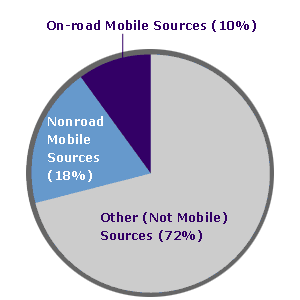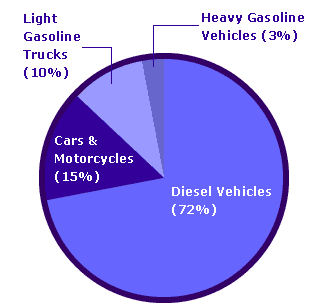Particulate Matter
1999 National Emissions by Source: Fine Particulate Matter (PM2.5)
 Particulate matter is the term for solid or liquid particles found in the air. Some particles are large or dark enough to be seen as soot or smoke, but fine particulate matter is tiny and is generally not visible to the naked eye. Mobile source particulate emissions consist mainly of these very tiny particles, also known as PM2.5, because they are less than 2.5 microns in diameter.
Particulate matter is the term for solid or liquid particles found in the air. Some particles are large or dark enough to be seen as soot or smoke, but fine particulate matter is tiny and is generally not visible to the naked eye. Mobile source particulate emissions consist mainly of these very tiny particles, also known as PM2.5, because they are less than 2.5 microns in diameter.
Click on a mobile source category for detailed information.
General information about other (not mobile) sources can be found at www.epa.gov/air/data/netdb.html and at www.epa.gov/air/urbanair/6poll.html
View the entire 1999 Trends Report for detailed information on hydrocarbon emissions by various sources.
Both on-road and nonroad mobile sources emit fine particulate matter. Diesel-powered vehicles and engines contribute more than half the mobile source particulate emissions.
Fine particulate matter is a health concern because very fine particles can reach the deepest regions of the lungs. Health effects include asthma, difficult or painful breathing, and chronic bronchitis, especially in children and the elderly. Fine particulate matter associated with diesel exhaust is also thought to cause lung cancer and is therefore listed as a mobile source air toxic. Fine particulate matter can travel long distances on air currents and is also a major cause of haze, which reduces visibility, affecting cities and scenic areas throughout the United States.
Learn more about particulate matter and haze and visibility. You can also find out about PM2.5 levels where you live.
1999 National Emissions by Source: Particulate Matter (PM2.5)
On-Road Mobile Sources

1999 National Emissions by Source: Particulate Matter (PM2.5)
Nonroad Mobile Sources

![[logo] US EPA](https://webarchive.library.unt.edu/eot2008/20081105165650im_/http://www.epa.gov/epafiles/images/logo_epaseal.gif)